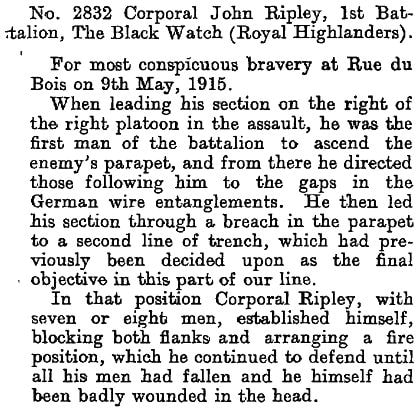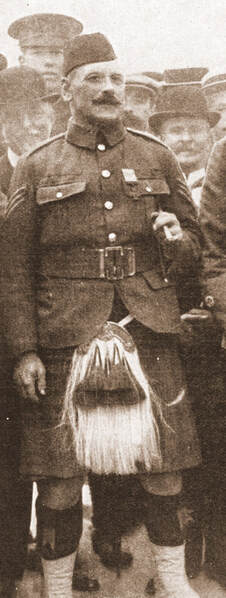Born in Keith, Banffshire on 30 August 1867 to general labourer Joseph Ripley and his wife Margaret Cassels, John Ripley was working as a wool spinner by the age of 13 at Isla Bank Mills in Keith, for G&G Kynoch tweed manufacturer. Two years later, he and his brother moved to Montrose, where they undertook an apprenticeship as slaters. However, at the time of the 1891 census John was in Bonhill in Dunbartonshire and his occupation was recorded in the census as railway porter. However, when he married Jane Laing in 1895 he was a journeyman slater, residing in St Andrews. His marriage was where John's connection to Largo began, as his wife hailed from New Gilston. Many will have heard of John Ripley (pictured above) as a recipient of the Victoria Cross and some may know that he is buried at the cemetery in Upper Largo.
John and Jane were married in New Gilston on 21 June 1895. Jane had been born there in 1867. Her father Alexander Laing was a coal miner, as was his father before him, Andrew Laing. Jane's mother was Agnes Gatherum, whose father Thomas was also a coal miner. This side of the family lived in neighbouring Woodside. According to A.S. Cunningham's 1907 book 'Upper Largo, Lower Largo, Lundin Links and Newburn', New Gilston was built around 1700 and owes its existence to coal mining. Gatherum was a common name around the area at that time. As well as Jane's mother being a Gatherum, her grandmother on her father's side was too. When Jane Laing married John Ripley they settled in St Andrews and that is where their son Alexander was born in 1896.
As well as setting up his own business as a slater, John was also a long-term member of the St Andrews Fire Brigade and the Rocket Brigade and was also a volunteer with the Black Watch territorials (which he had joined in 1884). By 1901, John, Jane and Alexander had taken in Jane's widowed father Alexander and also her sister Catherine Laing. All were living in College Street St Andrews and John was still working as a slater. in 1909, the family moved from College Street to North Street. The notice below from the 5 June St Andrews Citizen advises customers of the relocation of John's business as a slater and chimney sweep.
It was also in 1909 that John was awarded the Volunteers’ Long Service and Good Conduct Medal. He had served for many years in the 6th Volunteer Battalion, Black Watch, becoming a sergeant and one of his company's best shots. Three years later he retired from the Volunteers, after completing 18 years service. The Ripley household was now only John and Jane and their teenage son Alexander. At that point in time none of them could have foreseen the events that would unfold over the next few years.
John suffered the loss of his wife on 9 April 1913. Jane died at the age of 46 and was buried in her family's plot at Upper Largo cemetery where her mother, father and sister Agnes has already been laid to rest. When World War One broke out the following year, John initially acting as a recruiting sergeant. The photo below (from 'Fife: Portrait of a County 1910-1950' by Adamson and Lamont-Brown) shows him outside the Cupar recruiting office. His son Alexander, now aged 18, enlisted and joined the Royal Highlanders. Patriotic John eventually ended up enlisting himself at the age of 47 (despite the fact that the upper age limit was officially 41). He was sent to joint the 1st Battalion Black Watch and by Feb 1915 was in the trenches in France.
It was on 9 May 1915, while a corporal in the 1st Battalion, The Black Watch (Royal Highland Regiment) at the battle of Aubers Ridge, that the following deed took place for which he was awarded the Victoria Cross (below is how it was reported in The Gazette):
John was one of four men to be awarded the Victoria Cross (shown below) in that particular battle. One of the others was David Finlay from Guardbridge, close to where John lived in St Andrews (also of the Black Watch (Royal Highlanders)). Finlay was later killed in action in Mesopotamia on 21 January 1916.
Having recovered sufficiently from this injuries, the Victoria Cross was presented to John Ripley by King George V at Buckingham Palace on 12 July 1915. The photograph above shows four of that day's V.C. recipients leaving through the Palace gates. John is second from the right, wearing the kilt, being congratulated. The East of Fife Record reported on the event on 15 July (see below). Described in the article as a "stalwart Highlander", John confessed to being "a wee bit nervous" about meeting the King but soon felt as ease. His Majesty gave him a "fine hearty handshake" and said that "he was proud to decorate" John for his valour. John admitted his surprise at being awarded the V.C. and described in his own words the circumstances to his being awarded the medal. John also commented regarding his temporary return home: "I don't know how long I shall be back, but I hope to get as many recruits as I can". John's subsequent life as a V.C. holder will be covered the next post - from the remainder of the war to his burial with military honours at Upper Largo.










 RSS Feed
RSS Feed
